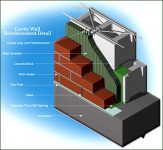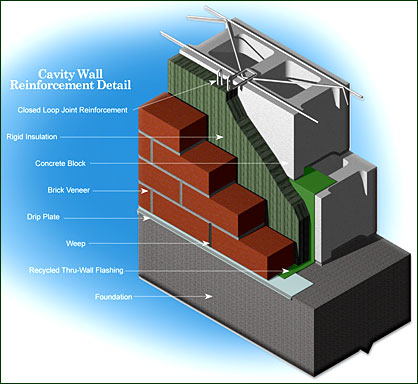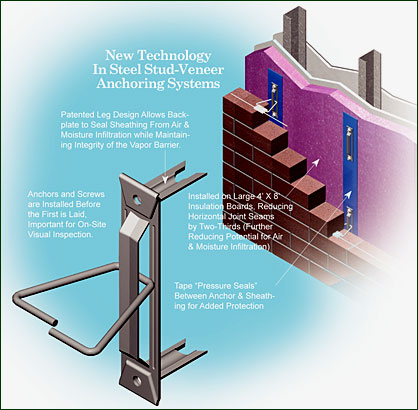Connectors, Anchors and Fasteners
A look at anchors, fasteners and connectors
By Christopher Bupp
As masonry wall design continues to evolve into the 21st century, terms like “air and vapor barriers,” “steel stud assemblies,” “rigid insulation versus batt insulation,” “ventilation with weeps and vents,” “clear air space,” and “oversize masonry units” are all employed to describe today’s masonry wall. Each one of these items can have a direct impact on wall reinforcing and anchoring systems. Add to that list things like “green” and “sustainable,” and, well, you get the idea. Masonry has gone through quite a transformation over the last handful of years.
The newest buzz words of green and sustainable have been linked with masonry itself for a number of years because of masonry’s local manufacture, recyclability, thermal mass characteristics and obvious history of longevity. Today, masonry units come in all different types, sizes and shapes. These newer products add even greater design flexibility with masonry, but also create the need for anchoring systems that have the adjustability to work with multiple type units in a single-wall design. While the masonry unit has always been considered green and sustainable, only recently have the wire reinforcing and anchoring systems followed suit to promote themselves as environmentally friendly with many products being made with as much as 99 percent post-industrial recycled material. This combination, along with the development of air/vapor barriers and flashings fabricated with a large percentage of recycled content, have placed masonry wall construction at the top of the list for green and sustainable building envelope systems. Another choice design professionals have been increasingly selecting is the use of stainless steel for both wire reinforcement and anchoring systems to provide even more corrosion resistance and longevity. More government facilities, college and university projects, and even K-12 projects are designed with stainless steel to match the 100-year life cycle of masonry.
The two options for horizontal joint reinforcing of masonry walls are the truss and ladder types. Truss reinforcement is a stronger product, because of its greater effective steel area. However, the ladder type has become increasingly popular because of its ability to handle more movement and deflection in the wall. More important, as more masonry walls incorporate vertical reinforcement, the design of the ladder type allows for the cores of the block to remain open, so as not to interfere with the placement of the vertical rebar. Both truss and ladder type reinforcements are available in mill-galvanized (interior use only), hot-dipped galvanized (exterior use) and stainless steel finishes. Wire diameters of nine gauges and 3/16 inches are available.
With the increasing availability of non-standard sizes of masonry units and veneer products, innovative and creative wall designs are now more common. This demands that the anchoring systems have the requisite adjustability to function correctly within these masonry walls. Building codes dictate a maximum of
1 1/4 inches of vertical adjustability for typical hook-and-eye anchoring systems, but with these modern wall designs, even more adjustability may be required. Products are now on the market that allow over three inches of vertical adjustability and maintain required load values.
Another hot topic is the development of new anchoring systems that eliminate the “disengagement” possibility of the anchor from the backup system. Most of these newer systems incorporate a “closed-loop” section for attachment of the anchor, thus eliminating the possibility of the anchor separating from the back-up resulting from differential movements. Additionally, some of the “closed-loop” systems allow the anchor to handle wall movement in both the vertical and horizontal directions.
High-strength anchoring systems have become necessary to meet design criteria in areas with high-wind loads, especially in multi-story structures. The ever-increasing awareness of seismic activity and its affect on masonry walls also requires the use of high-strength products that can meet the demanding needs of the earth’s natural disasters. In many cases, these systems include heavier gauge wire and metal components that require special manufacturing to meet today’s stricter codes. Processes like totally flat weld connection points and flattening of the pintle section in the veneer joint are absolutely necessary in these high-strength systems when the wire diameter may be as much as 1/4 inch to meet engineering requirements. Another factor that increases the need for these systems is today’s energy requirements, which in some parts of the country, may force the designer to use up to as much as four inches of rigid insulation in the cavity.
When running dew-point analysis in steel stud assemblies, it has become extremely popular to use rigid insulation in the cavity versus the old batt insulation in the studs to move that potential dew point out into the cavity area, thus minimizing condensation within the interior portion of the steel stud backup system. This concept has caused the need for increased thicknesses of insulation in the cavity, plus it has created the need for manufacturers to help the contractor in the field with attaching anchoring systems through the insulation and gypsum board.
Maybe the biggest change has taken place with regard to potential air and moisture infiltration in the wall assembly, and, more important, how we deal with keeping the building envelope as dry and energy efficient as possible. Anchoring systems certainly have become a major part of a successful building envelope, but not only from the anchoring standpoint. Today’s anchors must be compatible and function with all different types of both breathable and non-breathable air and vapor barriers. It is critical that the barrier’s integrity not be impaired, so as to maintain indoor air quality while also contributing to the structure’s energy compliance. In some cases, such as steel stud assemblies, the anchoring system will normally penetrate the air/vapor barrier and must provide an additional seal against air and moisture penetration at the outer-most point of the backup system. In CMU applications, the air/vapor barrier must be able to effectively seal around the previously installed anchors. In all cases the air/vapor barrier and the anchoring system need to be able to function properly together, thus requiring careful consideration during design and product selection.
Another veneer that has gained tremendous popularity during the last few years is the use of an almost unlimited number of real and imitation stone products. Developing anchoring systems for all the various types of stone materials (natural or synthetic) from different parts of the country has created a situation where most anchoring systems need to be “engineered” for each specific application. Once again, adjustability or flexibility of the placement of the anchor is paramount in these types of wall systems, keeping in mind the spacing requirements of a veneer system for the particular geographic region.
As things continue to change in the masonry industry and new wall systems are developed, the need for new and different types of anchoring products will continue to evolve. The high-performance wall concept will cause the masonry industry to look more closely at “systems” that incorporate, wire reinforcement, anchoring products, air/vapor barriers, flashings, control and expansion joints, weep and vents, mortar collection devices, drip plates, and termination bars into one functioning, fully tested system. The system concept needs to be embraced by our industry as we move forward.
Chrisopher Bupp, with Hohmann and Barnard Architectural Services, has been involved in the construction industry for more than 20 years. The building envelope has been his primary area of expertise. Contact Chris at chrisb@h-b.com.


